

10 Vegan Sources of Protein. Meat-eaters will never stop asking and vegans always get sick of hearing it: “How do you get your protein?”

The image of a skinny (not to mention gangly and dread-headed) hippie has typically been the poster child of veganism. After all, there’s no way we can be muscular, fit and even bulky as vegans, right? Wrong. Vegan athletes like Brendan Brazier, Rich Roll, and Jimi Sitko are changing the negative stereotypes, proving that plant-based protein can not only build strong muscles, but can keep a vegan healthy enough to run, swim, bike, dance or pump iron – no flesh-eating necessary. So how do you get your protein? 1.
5 Warning Signs You’re Not Getting Enough Protein. When I became vegetarian, I felt amazing right away.
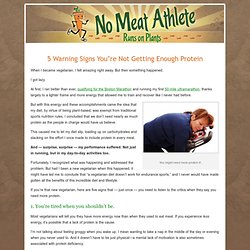
But then something happened. I got lazy. At first, I ran better than ever, qualifying for the Boston Marathon and running my first 50-mile ultramarathon, thanks largely to a lighter frame and more energy that allowed me to train and recover like I never had before. You might need more protein if... But with this energy and these accomplishments came the idea that my diet, by virtue of being plant-based, was exempt from traditional sports nutrition rules. This caused me to let my diet slip, loading up on carbohydrates and slacking on the effort I once made to include protein in every meal. And — surprise, surprise — my performance suffered. Fortunately, I recognized what was happening and addressed the problem. If you’re that new vegetarian, here are five signs that — just once — you need to listen to the critics when they say you need more protein. 1.
I’m not talking about feeling groggy when you wake up. 2. 3. Why? 4. 5. Talk to you soon, Triiodothyronine. This article is about triiodothyronine as a hormone.
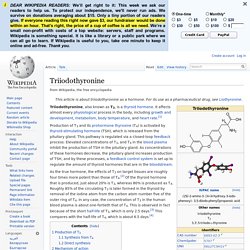
For its use as a pharmaceutical drug, see Liothyronine. Production of T3 and its prohormone thyroxine (T4) is activated by thyroid-stimulating hormone (TSH), which is released from the pituitary gland. This pathway is regulated via a closed-loop feedback process: Elevated concentrations of T3, and T4 in the blood plasma inhibit the production of TSH in the pituitary gland. As concentrations of these hormones decrease, the pituitary gland increases production of TSH, and by these processes, a feedback control system is set up to regulate the amount of thyroid hormones that are in the bloodstream.
As the true hormone, the effects of T3 on target tissues are roughly four times more potent than those of T4.[2] Of the thyroid hormone that is produced, just about 20% is T3, whereas 80% is produced as T4. Production of T3[edit] Synthesis from T4[edit] T3 is the more metabolically active hormone produced from T4. Direct synthesis[edit] L-DOPA. Therapeutic use[edit] Besides the central nervous system, L-DOPA is also converted into dopamine from within the peripheral nervous system.
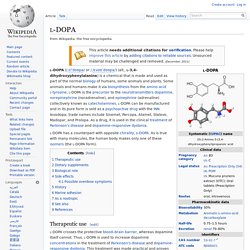
The resulting hyperdopaminergia causes many of the adverse side effects seen with sole L-DOPA administration. Nucleic acid. A comparison of the two principal nucleic acids: RNA (left) and DNA (right), showing the helices and nucleobases each employs.
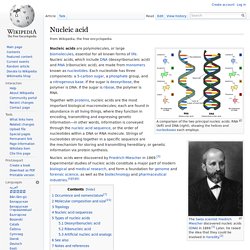
Nucleic acids are polymolecules, or large biomolecules, essential for all known forms of life. Nucleic acids, which include DNA (deoxyribonucleic acid) and RNA (ribonucleic acid), are made from monomers known as nucleotides. Each nucleotide has three components: a 5-carbon sugar, a phosphate group, and a nitrogenous base. If the sugar is deoxyribose, the polymer is DNA.
If the sugar is ribose, the polymer is RNA. Together with proteins, nucleic acids are the most important biological macromolecules; each are found in abundance in all living things, where they function in encoding, transmitting and expressing genetic information—in other words, information is conveyed through the nucleic acid sequence, or the order of nucleotides within a DNA or RNA molecule. Occurrence and nomenclature[7][edit] Molecular composition and size[15][edit] Glycoprotein. N-linked protein glycosylation (N-glycosylation of N-glycans) at Asn residues (Asn-x-Ser/Thr motifs) in glycoproteins.[1] N-glycosylation and O-glycosylation[edit] There are two types of glycosylation: In N-glycosylation, the addition of sugar chains can happen at the amide nitrogen on the side-chain of the asparagine.In O-glycosylation, the addition of sugar chains can happen on the hydroxyl oxygen on the side-chain of hydroxylysine, hydroxyproline, serine, or threonine.
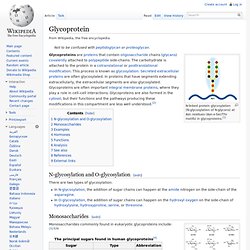
Monosaccharides[edit] Eight sugars commonly found in glycoproteins. Monosaccharides commonly found in eukaryotic glycoproteins include:[3]:526 The sugar group(s) can assist in protein folding or improve proteins' stability. Examples[edit] One example of glycoproteins found in the body is mucins, which are secreted in the mucus of the respiratory and digestive tracts. Protein (nutrient) Amino acids are the building blocks of protein.

Amino acids are necessary nutrients.